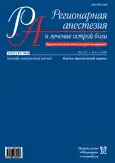Сравнение гемодинамических показателей у пациентов при трансуретральной резекции мочевого пузыря во время спинальной анестезии с использованием левобупивакаина и ропивакаина
- Авторы: Цыганков К.А.1, Корепанов А.Н.2, Лахин Р.Е.1, Щеголев А.В.1, Халиков А.Д.2, Матич А.И.1
-
Учреждения:
- ФГБВОУ ВО «Военно-медицинская академия им. С.М. Кирова» МО РФ
- Санкт-Петербургское ГУЗ «Городской клинический онкологический диспансер»
- Выпуск: Том 12, № 4 (2018)
- Страницы: 250-256
- Раздел: Оригинальные статьи
- URL: https://journals.rcsi.science/1993-6508/article/view/61297
- DOI: https://doi.org/10.17816/1993-6508-2018-12-4-250-256
- ID: 61297
Цитировать
Полный текст
Аннотация
Целью исследования стало сравнение гемодинамических изменений при использовании ропивакаина и левобупивакаина у пациентов при проведении спинальной анестезии. Материалы и методы: в исследование были включены 48 пациентов, которые были рандомизированы на 2 группы, в зависимости от использованного анестетика: группа Р – ропивакаин, группа Л – левобупивакаин. Оценивали изменение среднего артериального давления и частоту сердечных сокращений. Результаты: у пациентов в группе Л отмечены стабильные показатели гемодинамики. Напротив, в группе Р на 12-й мин артериальная гипотензия зарегистрирована у 45,8% исследуемых, на 15-й мин выявлено в 37,5% случаях. На 18-й мин снижение среднего артериального давления отмечено у 41,6% пациентов, при этом в 12,5% случаев потребовало подключения вазопрессорной поддержки норадреналина в дозировке 0,07-0,15 мкг/кг/мин. При анализе частоты сердечных сокращений менее 60 уд/мин в группе Л выявлено не было. В то же время в группе Р синусовая брадикардия была зарегистрирована на всех этапах контроля частоты сердечных сокращений, а в некоторых случаях требовалась коррекция атропином. Выводы: течение анестезии в группе с использованием левобупивакаина характеризовалось стабильным средним артериальным давлением и частотой сердечных сокращений. У пациентов в группе ропивакаина отмечено снижение среднего артериального давления менее 70 мм рт.ст. в контролируемый период времени от 12,5 до 48,5%, с целью коррекции которой в 12,5% потребовалось использование вазопрессорной поддержки. Брадикардия в данной группе зарегистрирована в 12,5–54,1% случаев, при этом в 12,5% был использован атропин.
Полный текст
Открыть статью на сайте журналаОб авторах
Кирилл Алексеевич Цыганков
ФГБВОУ ВО «Военно-медицинская академия им. С.М. Кирова» МО РФ
Автор, ответственный за переписку.
Email: doctorcygankov@mail.ru
ORCID iD: 0000-0002-2357-0685
кандидат медицинских наук, преподаватель кафедры анестезиологии и реаниматологии
Россия, Санкт-ПетербургА. Н. Корепанов
Санкт-Петербургское ГУЗ «Городской клинический онкологический диспансер»
Email: doctorcygankov@mail.ru
ORCID iD: 0000-0002-6472-2868
Россия, Санкт-Петербург
Р. Е. Лахин
ФГБВОУ ВО «Военно-медицинская академия им. С.М. Кирова» МО РФ
Email: doctorcygankov@mail.ru
ORCID iD: 0000-0001-6819-9691
Россия, Санкт-Петербург
А. В. Щеголев
ФГБВОУ ВО «Военно-медицинская академия им. С.М. Кирова» МО РФ
Email: doctorcygankov@mail.ru
ORCID iD: 0000-0001-6431-439X
Россия, Санкт-Петербург
А. Д. Халиков
Санкт-Петербургское ГУЗ «Городской клинический онкологический диспансер»
Email: doctorcygankov@mail.ru
ORCID iD: 0000-0001-9864-1284
Россия, Санкт-Петербург
А. И. Матич
ФГБВОУ ВО «Военно-медицинская академия им. С.М. Кирова» МО РФ
Email: doctorcygankov@mail.ru
ORCID iD: 0000-0003-4387-0041
Россия, Санкт-Петербург
Список литературы
- Коробкин А.С., Терновой С.К., Пушкарь Д.Ю. Комплексная диагностика рака мочевого пузыря. Российский электронный журнал лучевой диагностики. 2012; 2 (4): 74–8.
- Горячев Р.В., Груздев В.Е., Рычков И.А. Опыт применения левобупивакаина для спинальной анестезии при урологических вмешательствах. Регионарная анестезия и лечение острой боли. 2018; 12 (1): 30–6.
- Baydilek Y., Yurtlu B.S., Hanci V. The comparison of levobupivacaine in continuous or single dose spinal anesthesia for transurethral resection of prostate surgery. Braz. J. Anesthesiol. 2014; 64 (2): 89–97. doi: 10.1016/j.bjane.2013.03.007.
- Lee Y.Y., Muchhal K., Chan C.K., Cheung A.S. Levobupivacaine and fentanyl for spinal anaesthesia: a randomized trial. Eur. J. Anaesthesiol. 2005; 22 (12): 899–903.
- Carpenter R.L., Caplan R.A., Brown D.L., Stephenson C. Incidence and risk factors for side effects of spinal anesthesia. Anesthesiology. 1992; 76 (6): 906–16.
- Dyamanna D.N., Zacharia B.T. Unexpected bradycardia and cardiac arrest under spinal anesthesia: case reports and review of literature. Middle East J. Anaesthesiol. 2013; 22 (1): 121–5.
- Klimscha W., Weinstabl C., Ilias W., Mayer N. Continuous spinal anesthesia with a microcatheter and low-dose bupivacaine decreases the hemodynamic effects of centroneuraxis blocks in elderly patients. Anesth. Analg. 1993; 77 (2): 275–80.
- Щеголев А.В., Цыганков К.А., Лахин Р.Е. Анализ частоты критических инцидентов при плановых оперативных вмешательствах на органах брюшной полости. Вестник Российской Военно-медицинской академии. 2016; 1 (53): 29–32.
- Akcaboy E.Y., Akcaboy Z.N., Gogus N.J. Low dose levobupivacaine 0.5% with fentanyl in spinal anaesthesia for transurethral resection of prostate surgery. Res Med Sci. 2011; 16 (1): 68–73.
- Foster R.H., Markham A. Levobupivacaine: a review of its pharmacology and use as a local anaesthetic. Drugs. 2000; 59 (3): 551–79.
- Erdil F., Bulut S., Demirbilek S. The effects of intrathecal levobupivacaine and bupivacaine in the elderly. Anaesthesia. 2009; 64 (9): 942–6. doi: 10.1111/j.1365-2044.2009.05995.
- Seetharam K.R., Bhat G. Effects of isobaric ropivacaine with or without fentanyl in subarachnoid blockade: A prospective double-blind, randomized study. Anesth. Essays Res. 2015; 9 (2): 173–7. doi: 10.4103/0259-1162.152149.
- Chaudhary A., Bogra J., Singh P.K. Efficacy of spinal ropivacaine versus ropivacaine with fentanyl in transurethral resection operations. Saudi J. Anaesth. 2014; 8 (1): 88–91. doi: 10.4103/1658-354X.125951.
- Cuvas O., Basar H., Yeygel A. Spinal anesthesia for transurethral resection operations: levobupivacaine with or without fentanyl. Middle East J. Anaesthesiol. 2010; 20 (4): 547–52.
- Lee Y.Y., Ngan Kee W.D., Muchhal K. Randomized double-blind comparison of ropivacaine-fentanyl and bupivacaine-fentanyl for spinal anaesthesia for urological surgery. Acta Anaesthesiol. Scand. 2005; 49 (10): 1477–82.








